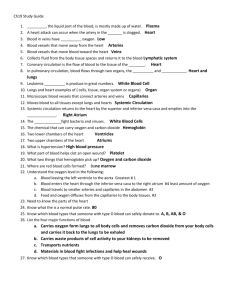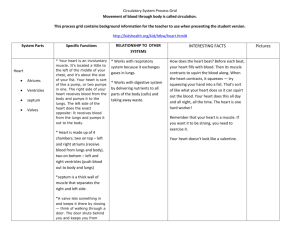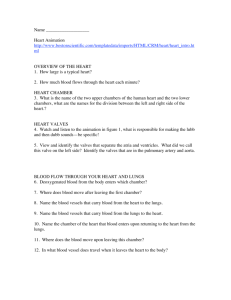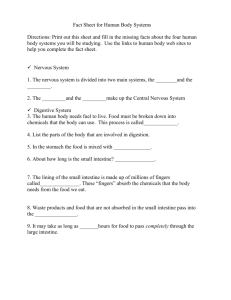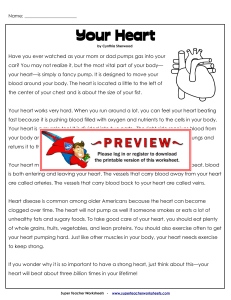THE CIRCULATORY & RESPIRATORY SYSTEM WEBQUEST
advertisement
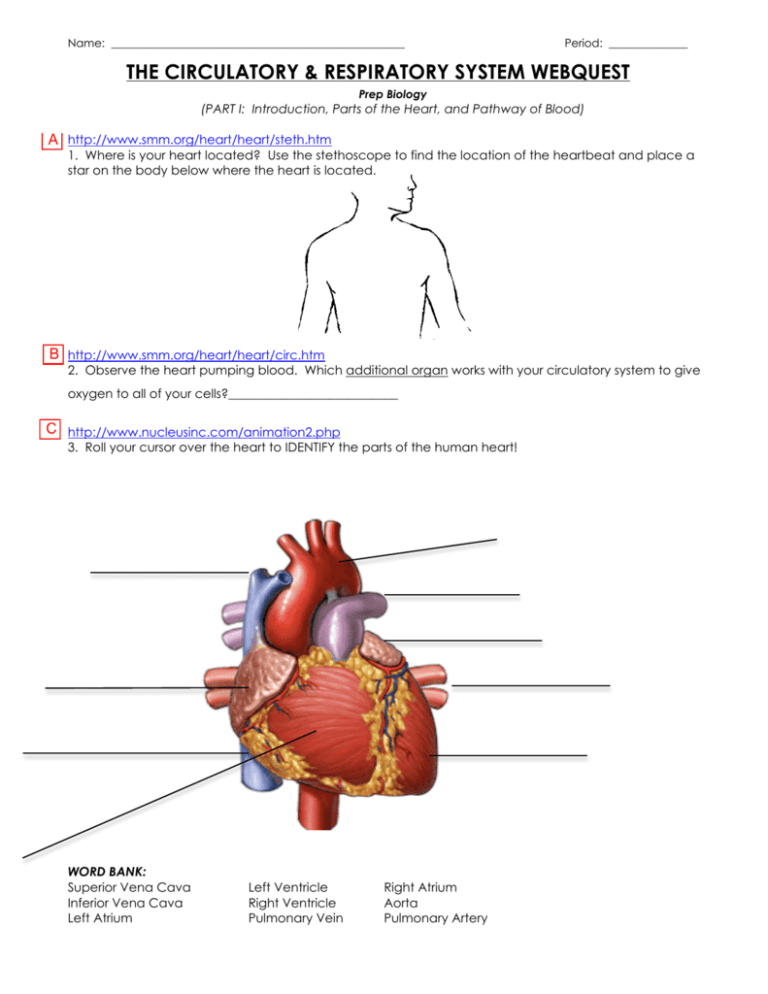
Name: ____________________________________________________ Period: ______________ THE CIRCULATORY & RESPIRATORY SYSTEM WEBQUEST CIRCULATORY WEBQUEST Prep Biology (PART I: Introduction, Parts of the Heart, and Pathway of Blood) A http://www.smm.org/heart/heart/steth.htm 1. Where is your heart located? Use the stethoscope to find the location of the heartbeat and place a star on the body below where the heart is located. B http://www.smm.org/heart/heart/circ.htm 2. Observe the heart pumping blood. Which additional organ works with your circulatory system to give oxygen to all of your cells?___________________________ C http://www.nucleusinc.com/animation2.php 3. Roll your cursor over the heart to IDENTIFY the parts of the human heart! In addition, circle the part with a BLUE pen or pencil to represent DEOXYGENATED BLOOD and use a RED pen or pencil to represent OXYGENATED BLOOD. WORD BANK: Superior Vena Cava Inferior Vena Cava Left Atrium Left Ventricle Right Ventricle Pulmonary Vein Right Atrium Aorta Pulmonary Artery 4. Flash Cards on Parts of the Heart D http://quizlet.com/1969655/parts-of-the-heart-and-their-functions-flash-cards/ Step One: View the flash cards several times. Step Two: Press on the box that is titled "LEARN." Try to type in the correct term that matches each description. Step Three: Press on the box that is titled "TEST." When you are done with the test, record the number of questions you had that where correct and the number that where incorrect. In addition, have your teacher sign the box that says "Completed Practice Test." Number of Questions Correct ____________/14 ______________________________________ Number of Questions Incorrect __________/14 Completed Practice Test (Teacher's Signature) NOTE: You do not need to know all of the terms in this activity. See the list below: Terms you ARE responsible for: Aorta Pulmonary Vein Pulmonary Artery Left Ventricle Oxygenated Right Ventricle Deoxygenated Arteries Right Atrium Veins Vena Cava Terms you are NOT responsible for: Coronary Vessels Bicuspid Valve Tricuspid Valve E http://www.purposegames.com/game/label-the-hearts-parts-quiz 5. Practice Practice will game to to identify thethe parts of the below. NOTE:record You must click 5. willmake makeperfect! perfect!Play Playthe the game identify parts of heart the heart below, your on "START" first! Call over Ms. Fullhart or Ms. Caliendo and a prize willl be awarded to the student who can time score in the box. Let your partner have a turn too! do it the fastest with 100% accuracy! How long did the game take you? (Does not matter how long as long as you can identify all of the parts!) ____________________________________________ F http://kidshealth.org/parent/general/body_basics/heart.html About the Heart and Circulatory System 6. What What are main parts parts of system? 6. are the thethree two main ofthe thecirculatory circulatory system? A. _________________________ A. ____________________ B. __________________________ C. _________________________ B. ________________________ 7. In class, during brain pop, we learned about three types of circulation. This website does not discuss coronary the type of circulation movement of blood in and around the heart. Define the other 7. Definecirculation, the two types of circulation in the human body. types of circulation discussed on the site. Pulmonary Circulation: _______________________________________________________________________________ Systemic Circulation: _________________________________________________________________________________ Clickon on"Body "BodyBasics: Basics:Heart" Heart"View Viewthe theanimation animationofofblood bloodflow flowthrough throughthe theheart heartand andfillfillininthe theblanks blanksbelow. Click below. When blood circulates in the body, it enters the heart through the _______________________________, [asses When blood circulates in the body, it enters the heart through the _______________________________, passes through to the _______________________________, and flows out through the __________________________ to through to the _______________________________, and flows out through the __________________________ to the _________________________-where it picks up _____________________ and gets rid of the _________________________-where it picks up _____________________ and gets rid of __________________________________. From the lungs, blood returns to the ______________________________ __________________________________. From the lungs, blood returns to the ______________________________ and enters the _____________________________ where it is pumped to the body through the _______________. and enters the _____________________________ where it is pumped to the body through the _______________. http://www.youtube.com/watch?v=mH0QTWzUxI&safety_mode=true&persist_safety_mode=1&safe=active http://www.youtube.com/watch?v=FCimR_P9ID0&feature=related&safety_mode=true&persist_safety_mo de=1&safe=active G http://www.aboutkidshealth.ca/En/HowTheBodyWorks/IntroductiontotheHeart/TheHeartbeat/Pages/ http://www.heartpoint.com/theheart.html BloodFlowThroughtheHeart.aspx Watch the videos above on the pathway of blood. Write out the flow of blood from the time it enters the Watch the on the of blood.outline Read each the text to write out the to heart to theanimation time it leaves the pathway heart. In addition, boxbelow with a the red animation or blue pen/colored pencil flow of blood from the time it enters the heart to the time it leaves the heart. In addition, outline show low levels of oxygen (BLUE) and high levels of oxygen (RED). each box with a red or blue pen/colored pencil to show low levels of oxygen (BLUE) and high levels of oxygen (RED). Valve From Above the Heart Valve OR From Below the Heart Valve Pulmonary Artery Valve The entire body Body http://www.sciencelearn.org.nz/Contexts/See-through-Body/Sci-Media/Animations-andInteractives/Label-the-heart H http://www.e-learningforkids.org/Courses/Liquid_Animation/Body_Parts/Heart_and_Circulation/index.html 4. Which blood vessel is the site of diffusion, where oxygen is dropped off and carbon dioxide is picked up? Click "Let's Go!" a. artery Click on "Blood Pressure" b. capillary c. vein Veins contain that ispressure be just as dangerous as having high blood pressure? _____________ 1.5.Why can havingblood low blood a. high in oxygen. b. low in oxygen. c. both high and low in oxygen. _______________________________________________________________________________________________________ 6. Veins carry blood a. away b. to the heart. c. both away and to the heart. Click "Main Menu"from the heart. Click "Arteries" 2.http://www.e-learningforkids.org/Courses/Liquid_Animation/Body_Parts/Heart_and_Circulation/index.html Why is the blood in your arteries bright red? _________________________________________________________ Click "Let's Go!" on "Blood 3.Click As arteries get Pressure" farther and farther away from the heart they get smaller and smaller and branch into tiny 1. Why can having low blood pressure be just as dangerous as having high blood pressure? _____________ blood vessels called _______________________________________. _______________________________________________________________________________________________________ Click Menu" Click"Main "Replay" Click "Capillaries" Click "Arteries" 4. What is the function of capillaries in your body? ______________________________________________________ 2. Why is the blood in your arteries bright red? _________________________________________________________ 5. Label the diagram below: 3. As arteries get farther and farther away from the heart they get smaller and smaller and branch into tiny blood vessels called _______________________________________. Click "Replay" Click "Capillaries" 4. What is the function of capillaries in your body? ______________________________________________________ 5. Label the diagram below: 6. Why does the blood change color as it leaves the capillaries? ________________________________ _______________________________________________________________________________________________________ Click "Main Menu" Click "Veins" 7. Veins collect blood from ____________________________ and bring it back to the heart. 6. Why does the capillary change color as it passes buy your body cells? ________________________________ 8. Why is the blood in veins dark red (blue)? ___________________________________________________________ _______________________________________________________________________________________________________ 9. Inside your veins there is ___________________________ pressure. a. high b. low Click "Replay" Click "Veins" Now, it is time to see how much you have learned! 7. Veins collect blood from ____________________________ and bring it back to the heart. Take the quiz below on the blood vessels found in your body! 8. Why is the blood in veins dark red (blue)? ___________________________________________________________ Quiz on Blood Vessels 9. Inside your veins there is ___________________________ pressure. a. high b. low Now, it is time to see how much you have learned! Take the quiz below on the blood vessels found in your body! Good Luck! All about blood Part III: Blood I http://www.e-learningforkids.org/Courses/Liquid_Animation/Body_Parts/Blood/index.html 1. Be a scientist and take a closer look at the components of blood! Click on each cell to findout more about it and answer the questions below. Note: You will have to click "Main Menu" to view the function of each of blood. "Replay" to view the function of each partpart of blood. Component (Part) of Blood Job What do they look like? Red Blood Cells White Blood Cells (Monocytes/Macrophages) Platelets See the facts below the blood vessel to answer the questions below. 1. Where are blood cells made? _____________________________________________________________________ 2. True or False: White blood cells can leave the blood vessels and travel into your tissues. Why would this be an advantage? ___________________________________________________________________________________ See the facts below the blood vessel to answer the questions below. ______________________________________________________________________________________________________ Click on red-yellow circle "where is blood made?" 3. What are the four blood types? 1. Where are blood cells made? _____________________________________________________________________ A. B. C. D. 2. True or False: White blood cells can leave the blood vessels and travel into your tissues. Why would this 4. Which blood type is most common? _______________________ be an advantage? ___________________________________________________________________________________ 5. What is "blood count?" _____________________________________________________________________________ ______________________________________________________________________________________________________ Click on "Yucky Bites" Click on blood bag type "A" 6. What is in pus? ____________________________________________________________________________________ 3. What are the four blood types? 7. Why does blood taste salty? ______________________________________________________________________ A.____________________ B. ___________________ C. ________________ D. _________________ http://www.wisc-online.com/objects/index_tj.asp?objID=AP14604 BLOOD 4.RED Which bloodCELLS type is most common? _______________________ 1. Blood is called the “River of ____________________”because it carries: Click on blood test tube 2. _____________is the FLUID COMPONENT of blood and makes up___________%. 5. What is "blood count?" _____________________________________________________________________________ Click on "Yukky Bits" 3. ____________makes up the remaining percentage of blood. 6. What is in pus? ____________________________________________________________________________________ 7. Why does blood taste salty? ______________________________________________________________________ Let'sThe explore the respiratory Respiratory System system! Webquest J http://science.nationalgeographic.com/science/health-and-human-body/human-body/lungs-article/ The Breath of Life-National Geographic 1. Our lungs are, essentially, a network of connected ________________ that bring _________________ from the air into our ______________, nourishing the trillions of cells that make up our bodies. The lungs also _______________ the blood of _______________________ waste created when cells use oxygen. We breathe in _____________________ times per day! Click on "Lung Anatomy" at the bottom of the page 2. Using the information in this section, to label the diagram. Also known as the windpipe ________________________ Larger branches that lead from the trachea are called ______________________ Tinysmallest tubes branching The branchesout are called from bronchi ______________________ Click on "Alveoli" 3. What occurs at the alveoli? Muscle that lies beneath the lungs is called the ___________________________ A. What is dropped off at the lungs by the blood vessels? ___________________________ B. What is picked up at the lungs by the blood vessels? ____________________________ 4. Using the information in this section, to label the diagram. Tiny air sacs found at the end of the bronchioles are called These surround the tiny air sacs __________________________ ____________________ _______ Click on "Lung Functions" 5. What part makes your lungs inflate (expand) and deflate (contract)? ____________________________ 6. What happens when the diaphragm is pulled down (Do you inhale or exhale)? ______________________ 7. What gas do you take in when you inhale? ___________________ When you exhale? ______________________ 8. What happens when the diaphragm relaxes (Do you inhale or exhale)? ______________________ 9. Summarize the pathway of air from the previous page by completing the following flowchart. 9. Pathway of Air: Nasal Cavity Pharynx Larynx _________________________ (Windpipe) OR Mouth _________________________ Tiny Air Sacs _________________________ Smallest branches _________________________ Small branches Blood Vessels (Capillaries) Click on "Affects of Asthma" 10. What happens when someone has an asthma attack? _________________________________________________ K http://www.lung.ca/children/grades7_12/respiratory/respiratory_system.html SCROLL DOWN and read under the diagram _________________________________________________________________________________________________ 1. The nasal cavity has two functions. One is to ____________________ the air that is entering and the other is to 11. Draw a normal bronchiole below versus a bronchiole of someone having an asthma attack: trap particles in its _________________________. NORMAL BRONCHIOLE: BRONCHIOLE DURING AN ASTHMA ATTACK: 2. What is the epiglottis? ________________________________________________________________________ What is the function of the epiglottis? _______________________________________________________________ 3. What is another name for the larynx? ______________________________ Why is this a good nickname for the larynx? ________________________________________________________ _______________________________________________________________________________________________ 12. What can trigger or cause an asthma attack? (Identify three) L http://kidshealth.org/kid/talk/qa/yawn.html Fill in the blanks that describe the three hypotheses as to why you may yawn: A. ___________________________ B. ________________________ C.just _______________________ Hypothesis #1: We yawn when we are are __________________or ________________, we don't breathe as deeply as we usually do. As this theory goes, our bodies take in less ________________________ because our 13. What does an inhaler do for someone with asthma? ____________________________________________________ breathing has _________________________. Therefore, yawning helps us bring more _________________________ _________________________________________________________________________________________________ into the blood and move more _______________________ out of the blood. http://lung.ca/children/grades4_6/respiratory/index.html Click on "Why do we breathe?" Hypothesis #2: Another theory is that yawning stretches the _________________________and lung tissue. Stretching 1. Explain how the respiratory system works with the circulatory system. ______________________________________ and yawning may be a way to flex muscles and joints, increase heart rate, and feel _____________________________. _______________________________________________________________________________________________ _______________________________________________________________________________________________ 2. We all know that humans use lungs in order to get oxygen, however not all organisms have lungs. Using the Hypothesis #3:found The on people believe describe that yawning is afollowing _____________________ ___________________ to redistribute information the website, how the organisms get oxygen: the oil-like substance called _________________________ that helps keep lungs lubricated inside and keeps them Organism How does this organism get its oxygen? from ________________________. So, if we didn't yawn, according to this theory, taking a deep breath would Sally the becomeSalamander ________________________ and ________________________ — and that would not be good! Both humans and birds have lungs, but the lungs of a bird are different. Explain how: Big Bird M http://kidshealth.org/kid/talk/qa/sneeze.html Solve some everyday mysteries about SNEEZING! 1. Why do you sneeze?_________________________________________________________________________ Maggie Mosquito 2. TRUE orthe FALSE: The only muscles involved in a sneeze are the chest and abdominal muscles. 3. TRUE or FALSE: A photic sneezer sneezes when exposed to bright light. Patty Plant 4. Write outthe a summary of another fact you find interesting: ______________________________________________ Both humans and reptiles have lungs, but the lungs of a reptile are different. Explain how: ______________________________________________________________________________________________ ______________________________________________________________________________________________ Lucky the Lizard Our diaphragm allows us to move air in/out of our lungs. Reptiles do not have a diaphragm. How ______________________________________________________________________________________________ are reptiles able to move air in/out of their lungs? http://kidshealth.org/kid/htbw/lungs.html 1. True or False: Just like your eyes, your lungs are the same size. 2. Your lungs are protected by your _______________________________ 3. What is the diaphragm? _______________________________________________________________________ 4. Go onto the next page and find the picture of the lungs. Draw a picture that includes the location of the lungs and the diaphragm. http://kidshealth.org/kid/watch/er/choking.html?tracking=K_RelatedArticle 1. True or False: You have two "pipes" or "throats?" When you choke, food or liquid goes down the wrong "pipe" or "throat." 2. Which pipe does it go down when choking? _____________________which leads to the ______________________. 3. Which pipe/throat SHOULD it go down? _________________________which leads to the _____________________. FINAL CHECK! Label all of the parts of the respiratory system shown below. In addition, use arrows to show where the oxygen flows from outside the human body until it reaches the capillaries. Part # Name of Part 1 2 3 Voicebox 4 Lung 5 Will have the same name as #9 6 7 8 9 10 Smallest Branches 11 1. Bronchi carries air into the ______________________________. 2. At the end of each bronchiole, there are clusters of tiny sacs called ___________________________________. 3. Where does the exchange of oxygen and carbon dioxide takes place? _______________________________ and _______________________________. 4. What is the muscle beneath your lungs that helps to move air in and out of the lungs? ________________________ 5. What is the flap of tissue that prevents food from entering the trachea and lungs? ____________________________


